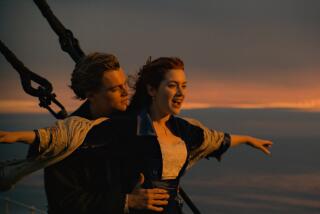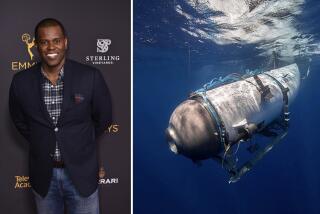Venturing fathoms below to Titanic
- Share via
NEW YORK — If a penny saved is a penny earned, you can earn yourself a cool $30,000 today.
That’s been the going price to plunge 12,000 feet to the North Atlantic seabed for a glimpse of the Titanic through the peephole of a cramped submersible.
But at 6 p.m. today, you can get a good look at the RMS Titanic on live TV. You won’t have to leave the house. And it won’t cost you a cent.
Airing on the National Geographic Channel (and repeating at 9 p.m.), “Return to Titanic” will take you on a scientific quest led by Robert Ballard, the marine explorer who found the sunken ruins of that luxury liner nearly 20 years ago and has since been championing her cause.
“This is a Super Bowl with 14 live cameras,” Ballard said, seeming almost as excited by the technology as by the expedition’s overriding purpose.
But the real reason for the 11-day mission, he said, is for scientists to map the ship and measure its deterioration since he last visited with a film crew a year after its discovery on Sept. 1, 1985.
The 32-member expedition team is already at work gathering and analyzing video of the wreckage from aboard the Ronald H. Brown. The National Oceanic and Atmospheric Administration research vessel is positioned over the site some 325 miles off the coast of Newfoundland. “Return to Titanic” will originate from there, with ABC correspondent Jay Schadler on deck as host.
But the most thrilling part of the hourlong program is sure to be live transmissions from the bottom of the sea, courtesy of multiple cameras perusing the wreckage from a trio of robotic vehicles dubbed Hercules, Little Herc and Argus.
Dispatched to inspect the Titanic from various perspectives (including interior probes), these remote-controlled devices are tethered to the Ronald H. Brown by fiber-optic cable, with their high-definition video beamed to the watching world by satellite.
By comparing these newly captured images to film shot in 1986, “we can show you exactly what’s happened in 20 years,” Ballard said, “and then analyze the damage: Is that Mother Nature at work? Or is it the hand of man?”
But the condition of this famous wreck will convey a larger message, Ballard said.
“I believe there’s more history in the deep sea than in all the museums of the world combined. But it’s a free-for-all, and what’s there is in peril.”
Since Ballard’s science-driven quests in 1985 and ‘86, the Titanic, he said, has received only visitors bent on “making a movie, selling tours or plundering.” So far, salvage operations have cost the Titanic more than 6,000 of its artifacts.
Ballard has long pushed for an international agreement to protect the Titanic and other shipwrecks as permanent memorials, with each of them available to visitors in a convenient, noninvasive way -- through what he calls “telepresence.”
On Monday’s program, he said, “I want to demonstrate that the Titanic is easily accessible, and has a much stronger statement to make, where it is: Something happened there, on that hallowed ground.”
What happened, of course, was the Titanic’s death blow the night of April 14, 1912. Its hull was ruptured by an iceberg, and more than 1,500 passengers and crew members -- about two-thirds of those on board -- perished when, less than three hours later, it sank to its final resting place.
Almost a century has passed, proving the Titanic truly unsinkable as a cautionary tale: human error on an epic scale, with tragedy to match. As much now as ever, it fascinates and haunts -- a fact certainly not lost on director James Cameron or the millions who watched his 1997 film dramatizing the disaster.
“The Titanic, because of its status, serves as a forum for us to talk about even bigger things,” Ballard said. “We’re a cultured society, and we don’t destroy our history -- even if it’s under water.”
More to Read
Sign up for The Wild
We’ll help you find the best places to hike, bike and run, as well as the perfect silent spots for meditation and yoga.
You may occasionally receive promotional content from the Los Angeles Times.






